The global sesbania gum powder market is valued at USD 224.6 million in 2025 and is projected to reach USD 348.8 million by 2035, growing at a CAGR of 4.5%. The sesbania gum powder market occupies a critical position within the natural hydrocolloids industry, serving essential applications across petroleum, textile, and food processing sectors. The trajectory from USD 224.6 million in 2025 to USD 348.8 million by 2035 demonstrates the expanding utilization of sesbania gum powder as industries prioritize natural thickening agents and environmentally conscious processing materials across diverse manufacturing operations.
Industrial modernization continues to drive adoption of sesbania gum powder, with sectors ranging from petroleum drilling to textile manufacturing implementing these products as core components in fluid viscosity control, thickening applications, and specialized processing operations. The growing emphasis on natural gum alternatives, cost-effective processing solutions, and enhanced operational performance creates consistent demand for gum products that deliver reliable rheological properties while reducing synthetic additive dependence and operational complexity. Sesbania gum powder addresses these requirements through natural polymer properties, excellent water solubility, and robust performance characteristics that withstand demanding industrial applications while providing superior thickening efficiency and processing consistency.
Regional market dynamics reveal distinct growth patterns influenced by industrial development levels, manufacturing capabilities, and natural gum adoption rates. Developed markets in North America and Europe demonstrate steady growth driven by equipment modernization, replacement cycles, and advanced processing methods that prioritize natural hydrocolloid systems. Emerging markets in Asia-Pacific show accelerated expansion supported by rapid industrialization, textile development, and increasing adoption of cost-effective natural gum technologies. The competitive landscape encompasses established gum manufacturers alongside specialized hydrocolloid solution providers, creating a diverse ecosystem that serves various market segments with tailored solutions.
The first half of the decade (2025-2030) will see the sesbania gum powder market climb from USD 224.6 million to approximately USD 269.1 million, adding USD 44.5 million in value, which represents 35.8% of the total forecast growth period. This phase will be characterized by the rapid adoption of advanced sesbania gum processing technologies, driven by increasing demand for natural thickening solutions and enhanced industrial capabilities worldwide. Superior viscosity performance and processing efficiency will become standard expectations rather than premium options.
The latter half (2030-2035) will witness continued growth from USD 269.1 million to USD 348.8 million, representing an addition of USD 79.7 million or 64.2% of the decade's expansion. This period will be defined by mass market penetration of specialized gum systems, integration with comprehensive processing platforms, and seamless compatibility with existing industrial infrastructure. The sesbania gum powder market trajectory signals fundamental shifts in how manufacturing facilities approach gum selection, with participants positioned to benefit from continued demand across multiple application segments.
The sesbania gum powder market demonstrates distinct growth phases with varying market characteristics and competitive dynamics. Between 2025 and 2030, the sesbania gum powder market progresses through its industrial application optimization phase, expanding from USD 224.6 million to USD 269.1 million with steady annual increments averaging 3.7% growth. This period showcases the transition from synthetic thickening agents to advanced sesbania gum systems with enhanced viscosity performance and integrated processing becoming mainstream features.
The 2025-2030 phase adds USD 44.5 million to market value, representing 35.8% of total decade expansion. Market maturation factors include standardization of gum specifications, declining production costs for sesbania gum powder, and increasing industrial awareness of natural alternatives reaching 85-90% effectiveness in petroleum and textile applications. Competitive landscape evolution during this period features established manufacturers like Shree Ram and Altrafine Gums expanding their sesbania gum portfolios while new entrants focus on specialized natural polymer solutions and enhanced processing technology.
From 2030 to 2035, market dynamics shift toward comprehensive industrial integration and multi-application deployment, with growth accelerating from USD 269.1 million to USD 348.8 million, adding USD 79.7 million or 64.2% of total expansion. This phase transition logic centers on universal sesbania gum systems, integration with advanced processing platforms, and deployment across diverse industrial scenarios, becoming standard rather than specialized gum formats. The competitive environment matures with focus shifting from basic gum performance to comprehensive processing excellence and compatibility with modern industrial operations.

| Metric | Value |
|---|---|
| Market Value (2025) | USD 224.6 million |
| Market Forecast (2035) | USD 348.8 million |
| Growth Rate | 4.5% CAGR |
| Leading Grade | Food Grade |
| Primary Application | Petroleum Industry Segment |
Petroleum industry applications drive primary demand, supported by increasing drilling requirements and enhanced industrial development solutions. Geographic expansion remains concentrated in developed industrial markets with established manufacturing infrastructure, while emerging economies show accelerating adoption rates driven by textile expansion and rising natural gum sophistication.
Market expansion rests on three fundamental shifts driving adoption across petroleum and textile sectors. Natural polymer preference growth creates compelling advantages through sesbania gum systems that provide comprehensive thickening properties with operational compatibility, enabling manufacturers to manage increasing viscosity requirements and maintain quality standards while ensuring cost-effective operations and justifying investment over synthetic thickening methods. Advanced processing modernization accelerates as companies worldwide seek reliable gums that deliver superior performance directly to industrial systems, enabling cost reduction that aligns with operational expectations and maximizes industrial productivity. Industrial transformation drives adoption from operators requiring specialized gums that maximize performance while maintaining high-quality reliability during petroleum and textile operations.
Growth faces headwinds from raw material cost variations that differ across gum suppliers regarding pricing stability and supply chain reliability, potentially limiting margin consistency in price-sensitive industrial categories. Processing complexity also persists regarding gum specifications and industrial requirements that may increase production costs in facilities with demanding quality standards.
The sesbania gum powder market represents a compelling intersection of natural polymer innovation, industrial processing advancement, and manufacturing optimization management. With robust growth projected from USD 224.6 million in 2025 to USD 348.8 million by 2035 at a 4.5% CAGR, this market is driven by increasing natural gum adoption expansion trends, advanced processing requirements, and demand for high-performance thickening formats.
The sesbania gum powder market's expansion reflects a fundamental shift in how industrial facilities and manufacturing operators approach natural gum infrastructure. Strong growth opportunities exist across diverse applications, from petroleum operations requiring high-viscosity gums to textile systems demanding reliable processing components. Geographic expansion is particularly pronounced in Asia-Pacific markets, LED by China (6.1% CAGR) and India (5.6% CAGR), while established markets in North America and Europe drive innovation and specialized segment development.
The dominance of food grade systems and petroleum industry applications underscores the importance of proven gum technology and industrial reliability in driving adoption. Gum standardization and processing complexity remain key challenges, creating opportunities for companies that can deliver seamless gum performance while maintaining processing efficiency.
Primary Classification: The market segments by grade into food grade, industrial grade, and pharmaceutical grade categories, representing the evolution from basic applications to high-purity industrial and food systems for comprehensive operations.
Secondary Breakdown: Application segmentation divides the sesbania gum powder market into petroleum industry, textile industry, food industry, and others sectors, reflecting distinct requirements for viscosity characteristics, processing specifications, and operational performance.
Tertiary Classification: End-use industry segmentation covers oil and gas, textiles, food processing, pharmaceutical manufacturing, construction materials, and specialty chemicals, representing diverse requirements for gum specifications and application performance.
Regional Classification: Geographic distribution covers North America, Europe, Asia Pacific, Latin America, and the Middle East & Africa, with developed industrial markets leading innovation while emerging economies show accelerating growth patterns driven by industrialization programs.
The segmentation structure reveals technology progression from standard gum systems toward integrated high-performance platforms with enhanced viscosity capabilities and precision performance, while application diversity spans from petroleum systems to textile processing requiring comprehensive gum properties and intelligent thickening solutions.
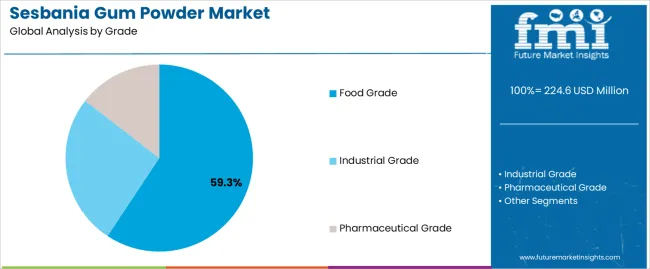
Food grade segment is estimated to account for 59.3% of the sesbania gum powder market share in 2025. The segment's leading position stems from its fundamental role as a critical component in modern food processing applications and its extensive use across multiple food and industrial sectors. The food grade range's dominance is attributed to its superior purity properties, including excellent safety standards, processing compatibility, and balanced cost-effectiveness that make it indispensable for food operations.
Market Position: Food grade systems command the leading position in the sesbania gum powder market through advanced processing technologies, including comprehensive purity properties, uniform quality, and reliable safety characteristics that enable operators to deploy gums across diverse food environments.
Value Drivers: The segment benefits from food industry preference for proven gum interfaces that provide exceptional purity performance without requiring ultra-premium processing costs. Efficient quality implementation enables deployment in food, pharmaceutical, and industrial applications where gum reliability and safety compatibility represent critical selection requirements.
Competitive Advantages: Food grade systems differentiate through excellent purity capacity, proven food safety reliability, and compatibility with standard processing methods that enhance gum capabilities while maintaining economical quality profiles suitable for diverse food applications.
Key market characteristics:
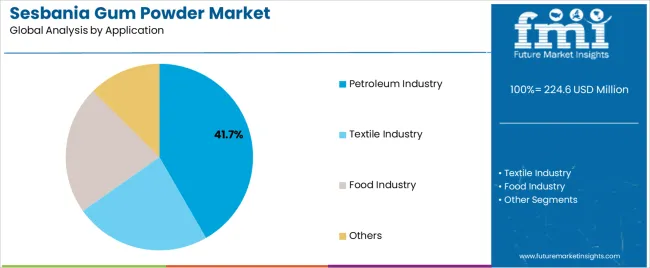
Petroleum industry segment is projected to hold 41.7% of the sesbania gum powder market share in 2025. The segment's market leadership is driven by the extensive use of sesbania gum powder in drilling operations, enhanced oil recovery, petroleum processing, and energy infrastructure, where gums serve as both a viscosity component and processing solution. The petroleum sector's consistent demand for reliable gum systems supports the segment's dominant position.
Market Context: Petroleum industry applications dominate the sesbania gum powder market due to widespread adoption of efficient gum solutions and increasing focus on drilling optimization, performance enhancement, and operational management that support petroleum operations while maintaining quality standards.
Appeal Factors: Petroleum consumers prioritize gum durability, viscosity performance, and integration with standard petroleum systems that enable coordinated deployment across multiple drilling needs. The segment benefits from substantial energy sector growth and petroleum development that emphasize reliable gums for drilling applications.
Growth Drivers: Petroleum programs incorporate sesbania gum powder as standard components for drilling systems and petroleum programs. At the same time, petroleum compliance initiatives are increasing demand for advanced features that comply with petroleum standards and enhance system performance.
Market Challenges: Gum cost fluctuations and standardization requirements may limit deployment flexibility in ultra-price-sensitive markets or regions with varying petroleum requirements.
Application dynamics include:
Oil and gas segment is anticipated to capture 38.4% of the sesbania gum powder market share in 2025. The segment's growth is driven by increasing drilling demand, petroleum processing initiatives, and sophisticated gum requirements that require high-quality viscosity systems. The oil and gas industry's expansion and focus on processing efficiency support this segment's robust performance.
Market Position: Oil and gas applications leverage sesbania gum powder for drilling systems in petroleum operations, processing manufacturing, extraction operations, and component integration where gum quality and viscosity precision are critical performance factors.
Growth Catalysts: Rising petroleum production, drilling development trends, and expanding processing capabilities drive demand for specialized gums that deliver consistent performance across diverse oil and gas applications.
Growth Accelerators: Natural polymer adoption expansion drives primary adoption as sesbania gum systems provide exceptional thickening properties that enable industrial development without performance compromise, supporting processing advancement and operational efficiency that require reliable gum formats. Advanced viscosity control growth accelerates market expansion as companies seek specialized gums that maintain performance during operation while enhancing industrial convenience through standardized specifications and compatibility. Natural gum awareness increases worldwide, creating continued demand for sesbania gum systems that complement industrial routines and provide operational advantages in processing performance.
Growth Inhibitors: Raw material cost volatility challenges differ across gum markets regarding price stability and supply chain consistency, which may limit margin predictability and cost planning in price-sensitive industrial categories with demanding affordability requirements. Processing complexity persists regarding gum specifications and industrial standards that may increase production costs in facilities with complex quality protocols. Market fragmentation across multiple gum specifications and application standards creates compatibility concerns between different gum systems and existing industrial infrastructure.
Market Evolution Patterns: Adoption accelerates in petroleum and textile sectors where gum benefits justify equipment investments, with geographic concentration in developed markets transitioning toward mainstream adoption in emerging economies driven by industrialization and processing expansion. Technology advancement focuses on enhanced viscosity properties, improved industrial performance, and integration with automated systems that optimize processing performance and quality control. The sesbania gum powder market could face disruption if alternative thickening technologies or processing changes significantly challenge traditional sesbania gum advantages in industrial applications.
The sesbania gum powder market demonstrates varied regional dynamics with growth leaders including China (6.1% CAGR) and India (5.6% CAGR) driving expansion through industrial manufacturing growth and processing modernization. Steady Performers encompass Germany (5.2% CAGR), Brazil (4.7% CAGR), and the USA (4.3% CAGR), benefiting from established industrial systems and advanced processing adoption.

| Country | CAGR (2025-2035) |
|---|---|
| China | 6.1% |
| India | 5.6% |
| Germany | 5.2% |
| Brazil | 4.7% |
| USA | 4.3% |
| UK | 3.8% |
| Japan | 3.4% |
Regional synthesis reveals Asia-Pacific markets leading growth through industrial expansion and processing development, while European countries maintain steady expansion supported by specialized applications and precision gum requirements. North American markets show strong growth driven by petroleum demand and industrial facility upgrades.
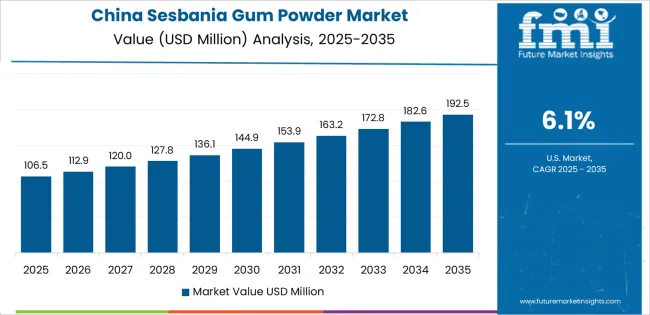
China establishes regional leadership through rapid industrial development and comprehensive processing modernization, integrating advanced sesbania gum systems as standard components in petroleum manufacturing and textile operations. The country's 6.1% CAGR through 2035 reflects industrial growth promoting manufacturing density and processing infrastructure development that mandate the use of reliable gum systems in industrial operations. Growth concentrates in major industrial centers, including Beijing, Shanghai, and Guangzhou, where industrial networks showcase integrated gum systems that appeal to manufacturers seeking enhanced production efficiency and international quality standards.
Chinese manufacturers are developing innovative sesbania gum solutions that combine local production advantages with international industrial specifications, including advanced polymer compositions and enhanced viscosity capabilities.
Strategic Market Indicators:
The Indian market emphasizes industrial manufacturing applications, including rapid processing development and comprehensive industrial expansion that increasingly incorporates sesbania gum powder for processing enhancement and textile applications. The country is projected to show a 5.6% CAGR through 2035, driven by massive industrial activity under processing initiatives and demand for standardized, high-quality gum systems. Indian industrial facilities prioritize cost-effectiveness with sesbania gum powder delivering industrial efficiency through economical gum usage and reliable performance capabilities.
Technology deployment channels include major industrial companies, textile integrators, and industrial institutions that support high-volume usage for industrial and textile applications.
Performance Metrics:
The German market emphasizes advanced industrial manufacturing features, including innovative gum technologies and integration with comprehensive industrial platforms that manage petroleum operations, industrial facilities, and institutional applications through unified gum systems. The country is projected to show a 5.2% CAGR through 2035, driven by industrial expansion under processing development trends and demand for premium, reliable gum systems. German industrial institutions prioritize precision with sesbania gum powder delivering comprehensive industrial performance through enhanced quality protection and operational innovation.
Technology deployment channels include major industrial companies, industrial institutions, and gum equipment manufacturers that support custom development for premium operations.
Performance Metrics:
In São Paulo, Rio de Janeiro, and Belo Horizonte, Brazilian industrial facilities and textile operators are implementing advanced sesbania gum systems to enhance viscosity capabilities and support operational performance that aligns with industrial protocols and processing standards. The Brazilian market demonstrates continued growth with a 4.7% CAGR through 2035, driven by industrial compliance programs and processing investments that emphasize reliable gum systems for industrial and textile applications. Brazilian industrial facilities are prioritizing sesbania gum systems that provide exceptional thickening properties while maintaining compliance with industrial standards and minimizing operational complexity, particularly important in industrial and textile facility operations.
Market expansion benefits from industrial programs that mandate enhanced gum compliance in processing specifications, creating continued demand across Brazil's industrial and textile sectors, where gum efficiency and system consistency represent critical requirements.
Strategic Market Indicators:
The USA market emphasizes industrial manufacturing features, including innovative gum technologies and integration with comprehensive industrial platforms that manage petroleum operations, industrial facilities, and commercial applications through unified gum systems. The country is projected to show a 4.3% CAGR through 2035, driven by industrial expansion under processing development trends and industry demand for premium, reliable gum systems. American industrial companies prioritize innovation with sesbania gum powder delivering comprehensive industrial performance through enhanced quality protection and operational advancement.
Technology deployment channels include major industrial companies, industrial institutions, and gum manufacturers that support custom development for industrial operations.
Performance Metrics:
The UK market demonstrates advanced industrial manufacturing deployment, growing at 3.8% CAGR, with documented operational excellence in petroleum control and industrial applications through integration with existing industrial systems and quality assurance infrastructure. The country leverages engineering expertise in industrial manufacturing and gum science to maintain market leadership. Industrial centers, including Manchester, Birmingham, and Liverpool, showcase advanced installations where sesbania gum systems integrate with comprehensive industrial platforms and petroleum systems to optimize industrial development and operational efficiency.
British industrial facilities prioritize gum precision and system consistency in product selection, creating demand for premium sesbania gum systems with advanced features, including enhanced polymer compositions and integration with automated industrial systems. The sesbania gum powder market benefits from established industrial infrastructure and willingness to invest in specialized gum technologies that provide superior quality and industrial compliance.
Market Intelligence Brief:
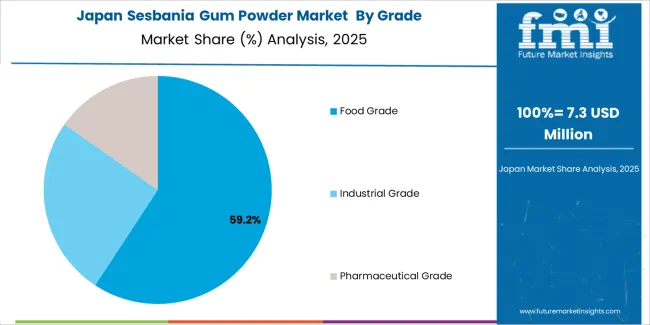
Japan's advanced industrial market demonstrates meticulous sesbania gum powder deployment, growing at 3.4% CAGR, with documented operational excellence in industrial control and petroleum applications through integration with existing industrial systems and quality assurance infrastructure. The country leverages engineering expertise in industrial manufacturing and gum technology to maintain market leadership. Industrial centers, including Tokyo, Osaka, and Nagoya, showcase advanced installations where sesbania gum systems integrate with comprehensive industrial platforms and quality systems to optimize industrial development and operational efficiency.
Japanese industrial facilities prioritize gum precision and system consistency in product selection, creating demand for premium sesbania gum systems with advanced features, including ultra-high quality and integration with automated industrial protocols. The sesbania gum powder market benefits from established industrial infrastructure and willingness to invest in specialized gum technologies that provide superior performance and industrial compliance.
Market Intelligence Brief:
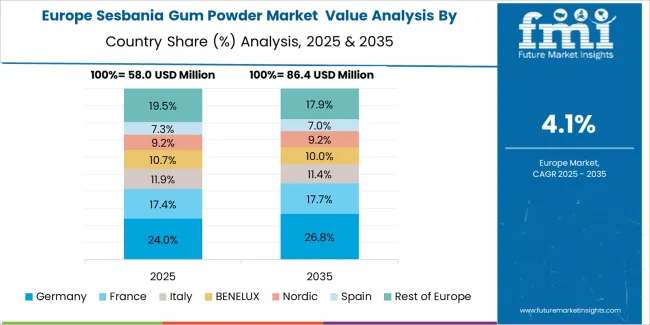
The sesbania gum powder market in Europe is projected to grow from USD 82.1 million in 2025 to USD 127.4 million by 2035, registering a CAGR of 4.5% over the forecast period. Germany is expected to maintain its leadership position with a 41.8% market share in 2025, declining slightly to 41.5% by 2035, supported by its industrial excellence and major industrial centers, including North Rhine-Westphalia and Bavaria.
France follows with a 24.2% share in 2025, projected to reach 24.5% by 2035, driven by comprehensive industrial programs and manufacturing facility initiatives. The United Kingdom holds a 18.7% share in 2025, expected to maintain 19.1% by 2035 through established industrial sectors and processing adoption. Italy commands a 9.8% share, while Spain accounts for 3.1% in 2025. The Rest of Europe region is anticipated to gain momentum, expanding its collective share from 2.4% to 2.6% by 2035, attributed to increasing industrial development in Eastern European countries and emerging processing programs implementing standardized gum systems.
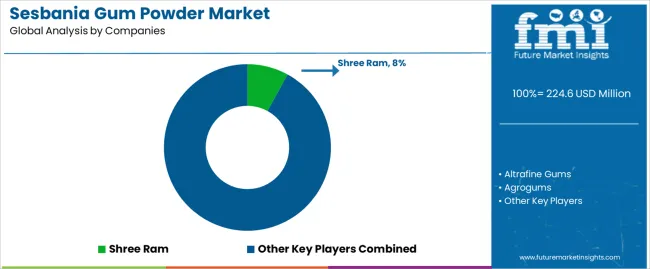
The sesbania gum powder market operates with moderate concentration, featuring approximately 12-18 participants, where leading companies control roughly 55-62% of the global market share through established distribution networks and comprehensive product portfolio capabilities. Competition emphasizes gum performance, industrial reliability, and processing optimization rather than premium feature rivalry.
Market leaders encompass Shree Ram, Altrafine Gums, and Agrogums, which maintain competitive advantages through extensive industrial manufacturing expertise, regional distribution networks, and comprehensive technical support capabilities that create industrial loyalty and support processing requirements. These companies leverage decades of gum experience and ongoing industrial technology investments to develop advanced sesbania gum systems with exceptional quality and industrial features.
Specialty challengers include regional manufacturers and gum specialists, which compete through specialized application innovation focus and efficient production solutions that appeal to industrial buyers seeking reliable performance formats and custom gum flexibility. These companies differentiate through operational efficiency emphasis and specialized market focus.
Market dynamics favor participants that combine consistent gum performance with advanced industrial support, including automated systems and distribution capabilities. Competitive pressure intensifies as traditional gum manufacturers expand into sesbania gum systems. At the same time, specialized industrial producers challenge established players through innovative manufacturing methods and cost-effective production targeting emerging industrial segments.
| Item | Value |
|---|---|
| Quantitative Units | USD 224.6 million |
| Grade | Food Grade, Industrial Grade, Pharmaceutical Grade |
| Application | Petroleum Industry, Textile Industry, Food Industry, Others |
| End-Use Industry | Oil and Gas, Textiles, Food Processing, Pharmaceutical Manufacturing, Construction Materials, Specialty Chemicals |
| Regions Covered | North America, Europe, Asia Pacific, Latin America, Middle East & Africa |
| Countries Covered | China, India, Germany, Brazil, USA, UK, Japan, and 25+ additional countries |
| Key Companies Profiled | Shree Ram, Altrafine Gums, Agrogums, Govind Madhav Industries |
| Additional Attributes | Dollar sales by grade and application categories, regional adoption trends across Asia Pacific, North America, and Europe, competitive landscape with gum manufacturers and industrial producers, customer preferences for gum characteristics and industrial performance, integration with industrial equipment and processing systems, innovations in gum technology and advanced industrial systems, and development of specialized gum solutions with enhanced properties and industrial-grade features |
The global sesbania gum powder market is estimated to be valued at USD 224.6 million in 2025.
The market size for the sesbania gum powder market is projected to reach USD 348.8 million by 2035.
The sesbania gum powder market is expected to grow at a 4.5% CAGR between 2025 and 2035.
The key product types in sesbania gum powder market are food grade, industrial grade and pharmaceutical grade.
In terms of application, petroleum industry segment to command 41.7% share in the sesbania gum powder market in 2025.






Full Research Suite comprises of:
Market outlook & trends analysis
Interviews & case studies
Strategic recommendations
Vendor profiles & capabilities analysis
5-year forecasts
8 regions and 60+ country-level data splits
Market segment data splits
12 months of continuous data updates
DELIVERED AS:
PDF EXCEL ONLINE
Gum Rosin Market Size and Share Forecast Outlook 2025 to 2035
Gummed Tape Market Size and Share Forecast Outlook 2025 to 2035
Gummy Supplements Market Size and Share Forecast Outlook 2025 to 2035
Gum Arabic Market Analysis – Size, Share, and Forecast Outlook 2025 to 2035
Gummy Market Analysis by Product, Ingredient, End-Use, Distribution Channel, and Region - Forecast through 2025 to 2035
Gum Turpentine Oil Market Growth - Trends & Forecast 2025 to 2035
Gum Hydrocolloid Market Analysis by Product Type, Source, and Region through 2035
Key Companies & Market Share in the Gummed Tape Sector
Evaluating Gum Fiber Market Share & Provider Insights
Gum Content Tester Market
CBD Gummies Market Analysis - Size, Share and Forecast Outlook 2025 to 2035
Pre-Gummed Labels Market Growth - Demand & Forecast 2025 to 2035
Guar Gum Market Size and Share Forecast Outlook 2025 to 2035
Guar Gum for Construction Market Size and Share Forecast Outlook 2025 to 2035
Tara Gum Market Size and Share Forecast Outlook 2025 to 2035
Sleep Gummy Market Analysis by Primary Ingredient, Customer Orientation, Pack Size and Product Claim Through 2035
Paper Gummed Tape Market Growth - Demand & Forecast 2025 to 2035
CoQ10 Gummies Market Analysis by Source, Distribution Channels, and Key Regions Through 2035
Ester Gums Market Growth – Trends & Forecast 2025 to 2035
Dammar Gum Market Size and Share Forecast Outlook 2025 to 2035

Thank you!
You will receive an email from our Business Development Manager. Please be sure to check your SPAM/JUNK folder too.
Chat With
MaRIA